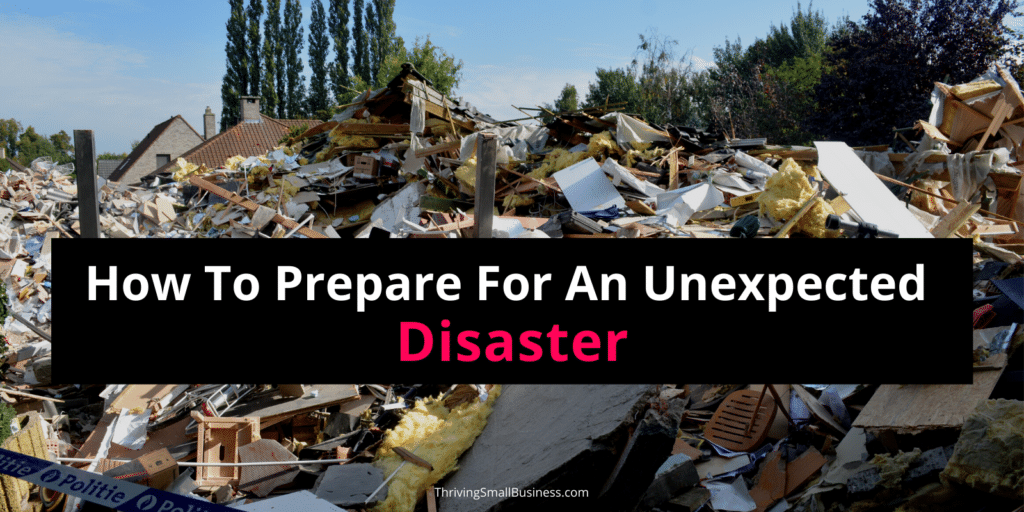How To Prepare Your Organization For An Unexpected Disaster
Estimated reading time: 5 minutes
We are at that time of year again when we experience many storms, tornadoes, and inclement weather.
These seasons of natural disasters remind us to be diligent and prepare our homes and businesses for the possibility of damage.
In addition, we need our organizations to be ready to respond in the event of an emergency or disaster.
All you have to do is imagine running your business without a computer, phone system, or even your current facility. You will quickly realize the importance of planning.
A disaster can be defined as a natural disaster (flood, hurricane, tornado, earthquake), an act of terrorism (9/11), or an armed intruder (Columbine).
Each of these scenarios has its own unique challenges, but some common things can and should be done to prepare.
Unfortunately, most emergencies or disasters happen without much warning. Even those with some warning don’t allow enough time to develop a disaster recovery plan.
What is a disaster recovery plan?
A disaster recovery plan is a written document that answers the questions: who, what, where, when, and how to get your business back up and running following a disaster or unexpected emergency.
This recovery plan manual can be as detailed as you’d like or as simple as thinking through some basic logistical first steps.
Obviously, the more detailed your plan is, the less “thinking” you will need to do at a time when there is chaos and many logistical challenges that need to be addressed.
Planning is Important
Imagine your business running without your computer systems, communication systems, employee support, or a functioning facility.
This planning process requires input from a team representing your senior leadership, information technology, telephone systems, employees, and facilities.

Once you have a plan in place, it is important to go through a “what if scenario” to test your plan.
Many organizations hold what they call disaster drills to test their plans and use the exercise to learn how to improve the plan.
It is amazing how different things look when you go through the process of implementing recovery steps.
I have worked with teams who have gone through these drills and cannot emphasize how valuable the experience is and is worth the time investment.
3 Phases of Recovery That Need a Plan
There are typically three phases of any disaster or emergency.
1. First Response
In the first response phase, the initial need is to ensure the safety and security of the facility and provide immediate help to possible victims.
This phase can include life-sustaining efforts, first aid, food, water, and basic living essentials.
This phase also includes being prepared to handle any media inquiries requiring an articulate scripted spokesperson to represent your organization.
Pay attention to interviews you watch following a disaster and consider how your organization would respond.
2. Clean-up Phase
The damage following a disaster can be overwhelming. This phase includes the cleanup of any destruction, focusing on preparing the facility for employees and customers to reenter.
In the case of an armed intruder, much thought should be placed on how employees will mentally prepare to return to work.
People who experience such emotional trauma need time to heal and often need help recovering.
This is where grief counseling may need to be explored.
Everyone is different; some people will bounce back more quickly than others.
Allow employees the time they need to grieve and provide the necessary help as long as needed.
3. Recovery Phase
The final phase after a disaster is the recovery phase.
This is the process of getting the facility back in order and ready to reopen for business.
Depending on the emergency or disaster, this may take a few days, weeks, or months.
In the case of a long-term recovery process, it is crucial to have an off-site command center where a leadership team can help facilitate the recovery process.
This is when you would be thankful that you had a manual to guide your steps!
Disaster Recovery Plan Manual
Steps of action for each of the three phases of recovery. This section is where you identify who, what, where, when, and how.
- Emergency contact information for Employees, Vendors, and Key Customers
- Information system requirements for hardware, software, and business data backup files
- Telephone system layout
- Diagrams of building layout
- IT Network Diagram
- Call tree of the leadership team – basically, what is the chain-of-command, who gets notified first, and who notifies whom.
Once the manual is completed, it should be one of several contents that should be placed in a disaster recovery box. This box should be kept at an off-site location.
Contents of the disaster recovery box should include:
- Disaster Recovery Plan Manual
- Employee Manual
- Copies of insurance policies and access to the document management system
Learn more ways to help your organization prepare for the unexpected. You can access Disaster Planning and Control here.
- Hard drive with computer software
- Access to cloud backup files on all key business data
- Employee contact information
- Key customer and vendor contact information
- Nametags for employees in case they need to be identified to cross into restricted areas.
- Basic office supplies (paper, pens, tape, stapler, etc.).
The box should be updated every six months to keep contents and contact information current.
There are some great resources available to help with your planning. Ready.gov and FEMA can also be used to help you prepare your organization for unexpected emergencies.
Lastly, there will always be unpredictable aspects to any disaster, but a little upfront planning can take a chaotic emergency situation and turn it into a smooth-running recovery process.







